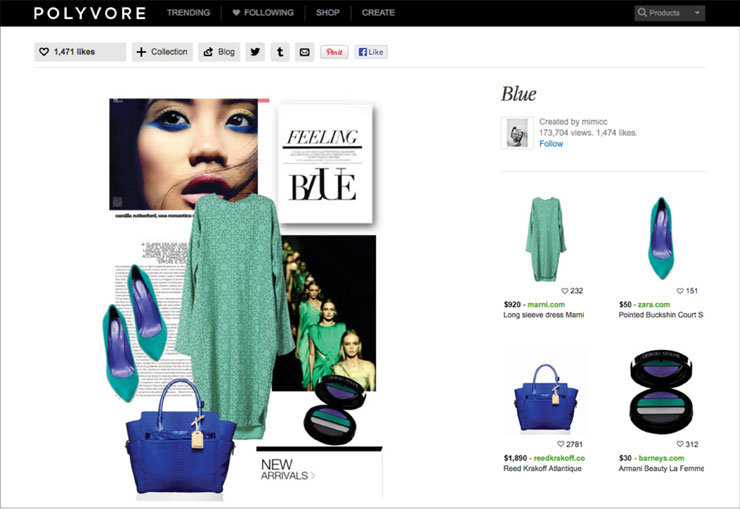You didn’t hear it from me, but there’s a new(ish) social media platform in town, and it’s carving open the ‘social media doesn’t drive revenue‘ conundrum.
Polyvore – a new way to discover and shop for things you love – is starting to become the new darling of social media, especially for retailers.
Unlike Pinterest, which is based on single images, Polyvore users can curate content to create fashion ‘sets’. bringing together makeup, clothes, shoes, accessories and more, to create a particular style or look. Individual products are tagged, pricing, and have a direct click through to the retail sites that sell them.
Inspiration drives sales, and Polyvore have set up a fantastic platform to ensure the path from social inspiration to purchase is as short as possible. Coupled with an average order value of $200, Polyvore drives more social sales than Pinterest, and four times as much as Twitter.
That got your attention, didn’t it?
It should come as no surprise that the biggest brands on Polyvore include Net-A-Porter, ASOS and Farfetch.com. They are leading the way when it comes to curating fashion content, using Polyvore to reach an audience that is ‘ready to buy’.
Is Polyvore Right For Me?
Clothing, luxury and design brands should look very closely at Polyvore, if it is not part of their current social media strategy.
In terms of audience, Polyvore’s top markets are the USA and UK, and their large female audience (74%) has significant spending power. 27% of Polyvore’s audience have a household income of $100k or more, making them a very lucrative audience for fashion and luxury brands in particular.
Where Do I Sign Up?
Before you dive in head first, it is worth getting an idea of what your competitors are up to on Polyvore. This will give you a better idea of how the platform works.
You’ll also need to get an idea of resource requirements, as curating content and creating sets takes time. You might also want to brief your creative team to get their input on template designs and brand imagery.
Also, give their clipper tool a try, to ensure that your products can be added to the site, and are ready to be viewed once you launch.
What Else Do I Need to Know?
Polyvore is a community of design, fashion and style influencers, so the same rules apply as another other social network. Engage, share, curate, and be helpful. The more active you are, the more recognition and engagement you’ll receive.
So much so, that Polyvore’s Shop section, which contains the most popular products, has its own mini-algorithm. ‘Increased engagement on Polyvore can also improve your results in our Shop section‘, say the Polyvore team.
Create, comment, compliment, read up on Polyvore Contests and Trophies.
Polyvore have many different options for native ads too, including Promoted Collections and Promoted Products.
Is Polyvore Just A Flash In The Pan?
Far from it. Polyvore have been profitable since 2011, have raised $22 million in funding, but most importantly, their values are driving the future of social commerce.
‘Do A Few Things Well‘ is their mantra, and polishing their platform, making it easy to use by brands and the general public, and making the social commerce path as short as possible, are the outcomes of that mantra.
Their second value? ‘Delight The User‘. This is what many brands struggle with across social media platforms – engagement and providing a tailored, personal experience. Polyvore have taken a step in front of the other social platforms and put retailers products at the heart of the site. That’s a win win for all parties.
Their final value is ‘Make An Impact‘. Polyvore are doing just that, with the platform now playing an impressive role in social commerce for many luxury and fashion brands.
Polyvore is starting to move the needle for social commerce, and its time many retailers sat up and took notice.
Are you using Polyvore? Let us know the good and bad bits in the comments below!




